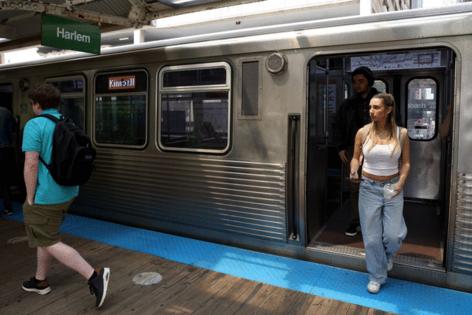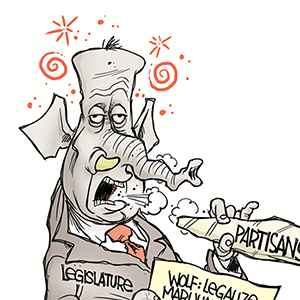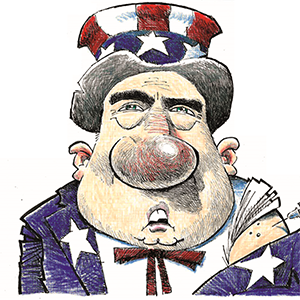Chicago Transit Authority proposes fare hikes as it stares down budget gap
Published in Business News
Chicagoans should expect to pay more for city trains and buses next year as the CTA looks to raise fares in the face of a looming fiscal crisis.
If the fare hikes of 25 cents per ride are approved by the agency’s board, it will be the first time the CTA has raised ticket prices since 2018.
The fare increases come as the CTA has warned it could have to cut bus and train service by as much as 25% starting in the middle of next year.
“The service cuts we may be forced to make beginning in 2026 will be the single-largest transit service cut in the modern history of the Chicago Transit Authority,” the agency’s acting president, Nora Leerhsen, warned earlier this month.
Like peer transit agencies around the country, the CTA is facing a fiscal crisis caused by the depletion of one-time federal pandemic aid — and ridership numbers that simply haven’t returned to pre-2020 levels.
The price hikes are laid out in the agency’s proposed 2026 budget, which was released Monday. All in all, the agency is proposing an operating budget worth about $2.09 billion next year, assuming it receives no new funding from state lawmakers.
The proposed fare increases will come whether or not there’s new funding.
Starting Feb. 1, the cost of a single CTA bus trip would jump from $2.25 to $2.50 under the new proposed fare regimen. The price of a train ride would go from $2.50 to $2.75.
CTA day passes would go from $5 to $6, a 20% jump. And monthly passes would jump from $75 to $85.
Reduced fares for bus trips would increase from $1.10 to $1.25, although reduced-fare train tickets will stay the same.
Leerhsen has said the price hikes would put about $30 million to $35 million back in the agency’s wallet next year.
But after using up its pandemic relief money and other dollars from one-time funding sources, CTA is looking at a $112 million budget gap next year. Without more state dollars, the agency said, it will need to make severe service cuts starting next summer.
The agency said it will cut administrative and management personnel before making service cuts.
Still, Chicagoans are looking at two rounds of bus and train service cuts in the near-term future: the first in August of next year and the second to take place by spring 2027, according to the budget.
The CTA has so far declined to offer specifics about exactly which bus routes and train lines would be on the chopping block. In the budget, the agency said it would “review every bus route and every rail line for overall productivity, equity, route coverage, and alternative transit service, including Metra and Pace service — with the goal of trying to reduce some of the impacts of service cuts on riders.”
Meanwhile, state lawmakers are getting ready to head to Springfield for their legislative veto session, which begins Tuesday. There, they’ll try to come to an agreement to pass legislation that would fund the region’s transit systems and avert the CTA’s worst-case scenario.
Efforts to pass such transit funding during lawmakers’ spring legislative session in May failed.
Meanwhile, the Regional Transportation Authority, which oversees the CTA along with commuter rail service Metra and suburban bus agency Pace, says it has worked to delay the impact of catastrophic service cuts.
In August, the RTA transferred $74 million in discretionary funds from Metra and Pace to the CTA to help stave off city service cuts next year.
The CTA was — and still is — expected to run out of federal relief dollars first, before Metra and Pace, neither of which expect to make cuts to bus or train service next year.
The shift in funding was intended to delay service cuts on the CTA by a few months to allow lawmakers more time to pass transit funding legislation, the RTA said.
But earlier this month, the RTA drew criticism — including from lawmakers — when it downsized the region’s estimated budget gap next year by hundreds of millions of dollars less than two weeks before veto session.
For months, the RTA had said the regional budget gap would top $770 million next year. But at a board meeting earlier this month, it revised that figure downward to just $200 million, attributing the difference mostly to an increase in projected state sales tax.
Without more state funding, the agency warned, the budget gap will balloon back up to $790 million in 2027 and beyond.
The CTA has prepared two other budgets in addition to its austerity budget: One “baseline” budget, which assumes state lawmakers plug the budget gap, and a “growth budget” which would be used if the legislature passes around $1.5 billion in new funding for the CTA, Metra and Pace, which has been the ask of transit advocates and agencies.
The baseline budget would allow the CTA to maintain current service levels and provide “modest improvements” for riders, it said. The “growth budget” would allow it to make more significant improvements, it said, such as by running CTA trains every eight minutes or less, all day, every day.
Separately, the CTA is proposing a five-year capital improvement program worth $6.75 billion.
The centerpiece of the program is the Red Line Extension, for which the CTA has marked down $3.8 billion in capital improvement funds. But the future of the project is uncertain. President Donald Trump’s White House took aim at it earlier this month when the administration froze around $2 billion in federal grant funding for the project, citing the CTA’s diversity requirements for contractors. The CTA locked down the final chunk of federal money for the project in January, before former President Joe Biden left office.
At the time, CTA officials said they weren’t worried about Trump clawing the money back.
The CTA’s 2026 budget is full-steam ahead on the extension, which would lengthen the Red Line from 95th Street to 130th Street and for which expected costs have ballooned. The budget refers to the federal grant funding as guaranteed and says major construction on the project is still expected to begin next year.
©2025 Chicago Tribune. Visit at chicagotribune.com. Distributed by Tribune Content Agency, LLC.












Comments